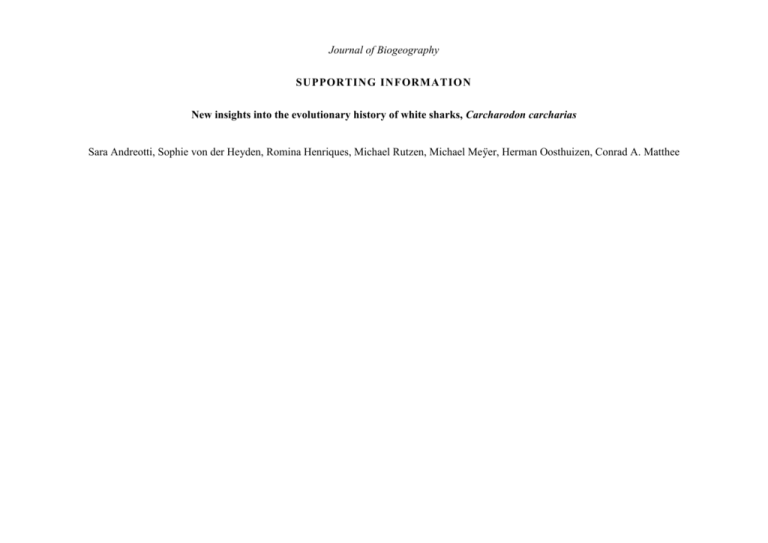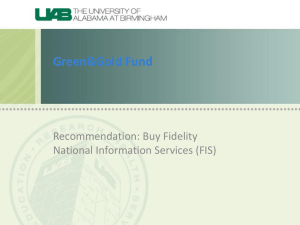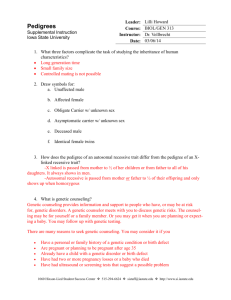jbi12641-sup-0001-AppendixS1-S4
advertisement

Journal of Biogeography SUPPORTING INFORMATION New insights into the evolutionary history of white sharks, Carcharodon carcharias Sara Andreotti, Sophie von der Heyden, Romina Henriques, Michael Rutzen, Michael Meÿer, Herman Oosthuizen, Conrad A. Matthee APPENDIX S1: (a) Photographic evidence of dorsal fins confirmed by genetic fingerprints that are identical and satellite telemetry evidences of the white shark’s dispersal potential around southern Africa coastline. The correspondence between photo identification and the genetic fingerprint of a white shark (3.7m Female) shows evidence of the reliability of the photographic identification to visually recognize the individuals (Figure S1a,b). For this study double sampling the same animals was avoided, whenever possible, by visually comparing the dorsal fins. Figure S1: The correspondence between photo identification, and the genetic fingerprint of a white shark (3.7m Female) shows evidence of the sharks’ movements across the coastline (a) Dorsal fin photo identification of the same shark sampled at Algoa Bay and False Bay; (b) Example of microsatellites score with the software Geneious version 5.6.5 (© Biomatters Ltd.) of two samples belonging to the same shark; (c) Genotype identity between the two samples; (d) satellite telemetry tracking of individual white sharks (each represented by a different colour) around southern Africa coastline, from the website: http://www.ocearch.org/#SharkTracker. APPENDIX S2: Microsatellites primers details, multiplex panels and annealing temperature. MULTIPLEX PANEL LOCUS PRIMERS Repeat CCa1419 ATTATCGCATTGGGGGATTT GCAGCAGTCACTCTTGGGTA CCTTAAAAGCACAGAACAAAGATAAA GGGGATTTACAGAGAGCATCC ACTCCGGATTGGTGCTATTG TTGGTCCTCCTTTGCTGAAT Dyes Range [TG]13 6-FAM 150-190 [TAGA]16 VIC 185-220 [TG]19 NED 230-270 CCa1273 TGTTTTTGCCTTTTATCCTTGAA CCAGAAACCCACCCAAGTAA [TG]10 PET 165-195 Ccar1 GCAGAGGTTGGGAAAGAGTT GCTATTCCAGTGACACTCTCC GATGATTTTGCATGTCACTTTGA CTTTGCCTAATATTATTGAGAGAT CCCTGTGTTCTTGCACAATG CCATTGAAGCCCTGTGAAGT GAGCATGTGTGGGAGCGAAAG TGGGACGATTCTGCCATTCTCTC [AC]22 6-FAM 155-170 [CA]19 VIC 165-195 [AC]26 NED 190-240 NA PET 165-186 ATGTGTGCAAGCAAGTCTGC GCATAACACCCCCACAGAAG CCTAGCATTATGGTCAACATCAG GGTCACTTTCAACTTGAGCAAA CTCTGGTTTCCTCCCAAGGT CAGGAGATGGGCACTACACA [TG]9[TG]11 6-FAM 230-250 [TG]21 VIC 155-195 [TG]12 PET 150-170 AGGAAATTAGGTGGGGAGGCAG GCCAAATAGATTCTGTCCTTGACCC AATGGGTTGTGATGGGAGTTT CAAGTGGAAGTCAAGCAGGTT GCTGAGTGCTGGCTGACCT TATCCAGTTACCATCTCCAAAAA [GA]18 6-FAM 110-130 [TG]23 NED 200-247 [TG]4TT[TG]9TT[TG]3TTTT[TG]23 PET 265-300 A CCa83 CCa1536 Annealing Temperature (°C) 50.0 Simplex 55.0 B 60.0 CCa711 CCa1072 Ccar6.27x C 60.6 CCa1466 CCa1276 CCa1226 D 63.2 Iox10 Ccar9 Ccar13 APPENDIX S3: Nuclear genetic diversity of C. carcharias at 14 microsatellite loci per sampling site: n – number of successfully genotyped individuals per locus; Na – number of alleles at each locus; HO – observed heterozygosity; HE – expected heterozygosity; AR – allelic richness; FIS – Inbreeding coefficient. Significant deviations from Hardy-Weinberg expectations, p<0.0001 after Bonferroni correction, are indicated by a *. Locus Cca1419 Cca83 Cca1536 Cca1273 Ccar1 Cca711 Cca1072 n Na Ho He AR FIS n Na Ho He AR FIS n Na Ho He AR FIS n Na Ho He AR FIS n Na Ho He AR FIS n Na Ho He AR FIS n Na Ho He AR Algoa Bay False Bay Gansbaai 9 3 1 0.582 3 -0.800 9 5 1.000 0.752 4 -0.358 9 5 0.889 0.719 11 -0.255 9 2 0.333 0.503 3 0.351 9 4 0.889 0.732 5 -0.231 9 5 0.556 0.641 7 0.111 9 5 0.556 0.667 20 167 3 1 0.519 3 -0.933 167 7 0.784 0.794 8 0.012 167 7 0.850 0.807 11 -0.053 167 2 0.419 0.443 3 0.054 167 6 0.743 0.696 5 -0.067 167 7 0.563 0.540 10 -0.050 167 8 0.689 0.815 20 11 3 1 0.567 3 -0.833 11 5 0.818 0.792 4 -0.034 11 7 0.818 0.840 11 0.027 11 2 0.364 0.416 3 0.130 11 4 0.909 0.710 5 -0.299 11 5 0.727 0.680 7 -0.143 11 8 0.727 0.857 20 Struisbaai De Hoop 18 3 1 0.586 3 -0.744 18 6 0.889 0.706 7 -0.268 18 6 0.944 0.783 11 -0.214 18 2 0.611 0.437 3 -0.417 18 4 0.778 0.624 5 -0.256 18 6 0.611 0.638 10 -0.067 18 7 0.722 0.775 20 Mossel Bay Overall 28 3 1 0.527 3 -0.931 28 7 0.786 0.820 8 0.043 28 7 0.786 0.825 11 0.048 28 2 0.571 0.486 3 -0.180 28 5 0.607 0.700 5 0.135 28 5 0.464 0.534 10 0.091 28 8 0.750 0.810 20 233 3 1.000 0.526 3 -0.906 233 7 0.803 0.789 6.2 -0.017 233 7 0.850 0.808 11 -0.051 233 2 0.446 0.446 3 0 233 6 0.742 0.691 5 -0.075 233 9 0.562 0.556 8.8 -0.036 233 8 0.695 0.807 20 Ccar627.x Cca1466 Cca1276 Cca1226 Iox10 Ccar9 Ccar13 FIS n Na Ho He AR FIS n Na Ho He AR FIS n Na Ho He AR FIS n Na Ho He AR FIS n Na Ho He AR FIS n Na Ho He AR FIS n Na Ho He AR FIS 0.175 9 3 0.667 0.621 4 -0.079 9 2 0.333 0.294 1 -0.143 9 7 0.778 0.843 13 0.082 9 3 0.556 0.464 5 -0.212 8 4 0.750 0.742 4 -0.012 8 7 0.750 0.800 11 0.067 8 3 0.750 0.667 2 0.056 0.158 11 2 0.182 0.173 4 -0.053 11 2 0.636 0.455 1 -0.429 11 6 1.000 0.836 5 -0.209 11 2 0.455 0.455 3 0.000 10 4 0.500 0.647 4 0.237 9 8 0.889 0.797 12 -0.123 8 3 0.750 0.633 2 -0.012 0.155* 167 3 0.461 0.452 4 -0.020 162 3 0.457 0.358 2 -0.276 163 16 0.933 0.874 15 -0.067 163 5 0.264 0.291 5 0.094 155 5 0.671 0.673 5 0.003 156 15 0.750 0.831 19 0.098* 148 3 0.696 0.595 2 -0.061 0.069 18 3 0.611 0.538 4 -0.140 18 2 0.278 0.246 1 -0.133 18 10 0.833 0.870 14 0.043 18 4 0.333 0.340 5 0.019 15 5 0.867 0.786 5 -0.106 15 10 0.733 0.862 13 0.154 12 3 0.667 0.627 2 -0.126 0.076 28 3 0.643 0.515 4 -0.254 26 3 0.538 0.419 2 -0.292 25 9 0.880 0.856 14 -0.029 26 4 0.346 0.389 5 0.112 26 5 0.615 0.626 5 0.017 25 12 0.880 0.832 14 -0.059 21 3 0.714 0.664 2 -0.071 0.139* 233 3 0.489 0.464 4 -0.054 226 3 0.456 0.358 1.4 -0.274 226 16 0.916 0.867 12.2 -0.057 227 5 0.299 0.322 4.6 0.069 214 5 0.673 0.677 4.6 0.006 213 15 0.770 0.828 13.8 0.07 197 9 0.701 0.607 2 -0.06 APPENDIX S4 Table S4: List of species, nucleotide (π) and haplotype (h) diversity and reference used to plot marine organism diversity value in Fig. S4. SPECIES π h REFERENCE Sharks Charcharodon carcharias SA Charcharodon carcharias AU Carcharodon carcharias CA Cetorhinus maximus Carcharhinus limbatus Carcharias taurus Sphyrna lewini Carcharinus leucas 0.003 0.007 0.001 0.001 0.002 0.003 0.013 0.003 0.205 0.868 0.660 0.720 0.805 0.717 0.800 0.760 This study Blower et al., 2012 Jorgensen et al., 2010 Hoelzel et al., 2006 Keeney et al., 2005 Stow et al., 2006 Duncan et al., 2006 Karl et al., 2011 Marine Mammals Physeter macrocephalus Orcinus orca Tursiops truncatus Delphinus delphis 0.002 0.005 0.013 0.012 0.860 0.874 0.420 0.853 Lyrholm et al., 1996 Hoelzel et al., 2002 Natoli et al., 2005 Natoli et al., 2006 Marine teleostei SA Clinus cottoides Hippocampus capensis Merluccius capensis Merluccius paradoxus Rhabdosargus holubii Caffrogobius caffer Argyrosomus japonicus 0.003 0.004 0.006 0.001 0.006 0.002 0.009 0.660 0.780 0.880 0.530 0.910 0.960 0.960 von der Heyden et al., 2008 Teske et al., 2003 von der Heyden et al., 2007 von der Heyden et al., 2010 Oosthuizen, 2007 Neethling et al., 2008 Klopper, 2005 Marine teleostei Merluccius australis Lophius piscatorius Lophius budegassa Cynoscion acoupa Girella punctata Acanthocybium solandri Lateolabrax japonicus Trachurus trachurus Lateolabrax maculates Ocyurus chrysurus Aphanopus carbo Helicolenus dactylopterus Scomber scombrus Pagrus pagrus Centropyge spp. Latris lineata 0.002 0.008 0.009 0.003 0.009 0.006 0.003 0.009 0.012 0.019 0.019 0.005 0.029 0.011 0.022 0.040 0.470 0.770 0.880 0.890 0.910 0.920 0.960 0.960 0.960 0.960 0.970 0.980 0.990 0.990 0.990 0.990 Machado-Schiaffino et al., 2009 Charrier et al., 2006 Charrier et al., 2006 Rodrigues et al., 2008 Umino et al., 2009 Theisen et al., 2008 Liu et al., 2006 Comesaña et al., 2008 Liu et al., 2006 Vasconcellos et al., 2008 Stefanni & Knutsen, 2007 Aboim et al., 2005 Nesbo et al., 2000 Ball et al., 2007 Bowen et al., 2006 Tracey et al., 2007 Figure S4 Graph showing mtDNA nucleotide and haplotype diversity for a range of marine organism (see Table 5 for species and references). South African species are indicated in red, white sharks are indicated by “■”. REFERENCES TABLE S4 Aboim, M.A., Menezes G.M., Schlitt T., & Rogers A.D. (2005) Genetic structure and history of populations of the deep-sea fish Helicolenus dactylopterus (Delaroche, 1809) inferred from mtDNA sequence analysis. Molecular Ecology, 14, 1343–1354. Ball, A.O., Beal M.G., Chapman R.W., & Sedberry G.R. (2007) Population structure of red porgy, Pagrus pagrus, in the Atlantic Ocean. Marine Biology, 150, 1321–1332. Blower, D., Pandolfi J., Bruce B., Gomez-Cabrera M., & Ovenden J. (2012) Population genetics of Australian white sharks reveals fine-scale spatial structure, transoceanic dispersal events and low effective population sizes. Marine Ecology Progress Series, 455, 229–244. Bowen, B.W., Muss A., Rocha L.A., & Grant W.S. (2006) Shallow mtDNA coalescence in Atlantic pygmy angelfishes (genus Centropyge) indicates a recent invasion from the Indian Ocean. Journal of Heredity, 97, 1–12. Charrier, G., Chenel T., Durand J.D., Girard M., Quiniou L., & Laroche J. (2006) Discrepancies in phylogeographical patterns of two European anglerfishes (Lophius budegassa and Lophius piscatorius). Molecular Phylogenetics and Evolution, 38, 742–754. Comesaña, A.S., Martínez-Areal M.T., & Sanjuan A. (2008) Genetic variation in the mitochondrial DNA control region among horse mackerel (Trachurus trachurus) from the Atlantic and Mediterranean areas. Fisheries Research, 89, 122–131. Duncan, K.M., Martin A.P., Bowen B.W., & De Couet H.G. (2006) Global phylogeography of the scalloped hammerhead shark (Sphyrna lewini). Molecular Ecology, 15, 2239–2251. Von der Heyden, S., Lipinski M.R., & Matthee C.A. (2007) Mitochondrial DNA analyses of the Cape hakes reveal an expanding, panmictic population for Merluccius capensis and population structuring for mature fish in Merluccius paradoxus. Molecular Phylogenetics and Evolution, 42, 517–527. Von der Heyden, S., Lipinski M.R., & Matthee C.A. (2010) Remarkably low mtDNA control region diversity in an abundant demersal fish. Molecular Phylogenetics and Evolution, 55, 1183–1188. Von der Heyden, S., Prochazka K., & Bowie R.C.K. (2008) Significant population structure and asymmetric gene flow patterns amidst expanding populations of Clinus cottoides (Perciformes, Clinidae): application of molecular data to marine conservation planning in South Africa. Molecular Ecology, 17, 4812–4826. Hoelzel, A.R., Natoli A., Dahlheim M.E., Olavarria C., Baird R.W., & Black N.A. (2002) Low worldwide genetic diversity in the killer whale (Orcinus orca): implications for demographic history. Proceedings of the Royal Society of London. Series B: Biological Sciences, 269, 1467–1473. Hoelzel, A.R., Shivji M.S., Magnussen J., & Francis M.P. (2006) Low worldwide genetic diversity in the basking shark (Cetorhinus maximus). Biology Letters, 2, 639–642. Jorgensen, S.J., Reeb C.A., Chapple T.K., Anderson S., Perle C., Van Sommeran S.R., Fritz-Cope C., Brown A.C., Klimley A.P., & Block B.A. (2010) Philopatry and migration of Pacific white sharks. Proceedings of the Royal Society B: Biological Sciences, 277, 679–688. Karl, S.A., Castro A.L.F., Lopez J.A., Charvet P., & Burgess G.H. (2011) Phylogeography and conservation of the bull shark (Carcharhinus leucas) inferred from mitochondrial and microsatellite DNA. Conservation Genetics, 12, 371–382. Keeney, D.B., Heupel M.R., Hueter R.E., & Heist E.J. (2005) Microsatellite and mitochondrial DNA analyses of the genetic structure of blacktip shark (Carcharhinus limbatus) nurseries in the northwestern Atlantic, Gulf of Mexico, and Caribbean Sea. Molecular Ecology, 14, 1911–1923. Klopper, A.W. (2005) Intraspecific genetic variation in the percoid teleosts, Argyrosomus japonicus (Temminck & Schlegel, 1843) and Pomadasys commersonnii (Lacepede, 1801) as inferred from the mitochondrial control region. University of Pretoria, South Africa. Liu, J.-X., Gao T.-X., Yokogawa K., & Zhang Y.-P. (2006) Differential population structuring and demographic history of two closely related fish species, Japanese sea bass (Lateolabrax japonicus) and spotted sea bass (Lateolabrax maculatus) in Northwestern Pacific. Molecular Phylogenetics and Evolution, 39, 799–811. Lyrholm, T., Leimar O., & Gyllensten U. (1996) Low diversity and biased substitution patterns in the mitochondrial DNA control region of sperm whales: implications for estimates of time since common ancestry. Molecular Biology and Evolution, 13, 1318–1326. Machado-Schiaffino, G., Campo D., & Garcia-Vazquez E. (2009) Strong genetic differentiation of the Austral hake (Merluccius australis) across the species range. Molecular Phylogenetics and Evolution, 53, 351–356. Natoli, A., Birkun A., Aguilar A., Lopez A., & Hoelzel A.R. (2005) Habitat structure and the dispersal of male and female bottlenose dolphins (Tursiops truncatus). Proceedings of the Royal Society B: Biological Sciences, 272, 1217–1226. Natoli, A., Canadas A., Peddemors V.M., Aguilar A., Vaquero C., Fernandez-Piqueras P., & Hoelzel A.R. (2006) Phylogeography and alpha taxonomy of the common dolphin (Delphinus sp.). Journal of Evolutionary Biology, 19, 943–954. Neethling, M., Matthee C.A., Bowie R.C., & von der Heyden S. (2008) Evidence for panmixia despite barriers to gene flow in the southern African endemic, Caffrogobius caffer (Teleostei: Gobiidae). BMC Evolutionary Biology, 8, 325. Nesbo, C.L., Rueness E.K., Iversen S.A., Skagen D.W., & Jakobsen K.S. (2000) Phylogeography and population history of Atlantic mackerel (Scomber scombrus L.): a genealogical approach reveals genetic structuring among the eastern Atlantic stocks. Proceedings of the Royal Society B: Biological Sciences, 267, 281–292. Oosthuizen, C.J. (2007) Genetic variation within the cape stumpnose, Steindachner(Teleostei: Sparidae). University of Pretoria, South Africa. Rhabdosargus holubi Rodrigues, R., Schneider H., Santos S., Vallinoto M., Sain-Paul U., & Sampaio I. (2008) Low levels of genetic diversity depicted from mitochondrial DNA sequences in a heavily exploited marine fish (Cynoscion acoupa, Sciaenidae) from the Northern coast of Brazil. Genetics and Molecular Biology, 31, 487–492. Stefanni, S. & Knutsen H. (2007) Phylogeography and demographic history of the deep-sea fish Aphanopus carbo (Lowe, 1839) in the NE Atlantic: Vicariance followed by secondary contact or speciation? Molecular Phylogenetics and Evolution, 42, 38–46. Stow, A., Zenger K., Briscoe D., Gillings M., Peddemors V., Otway N., & Harcourt R. (2006) Isolation and genetic diversity of endangered grey nurse shark (Carcharias taurus) populations. Biology Letters, 2, 308–311. Teske, P.R., Cherry M.I., & Matthee C.A. (2003) Population genetics of the endangered Knysna seahorse, Hippocampus capensis. Molecular Ecology, 12, 1703–1715. Theisen, T.C., Bowen B.W., Lanier W., & Baldwin J.D. (2008) High connectivity on a global scale in the pelagic wahoo, Acanthocybium solandri (tuna family Scombridae). Molecular Ecology, 17, 4233– 4247. Tracey, S.R., Smolenski A., & Lyle J.M. (2007) Genetic structuring of Latris lineata at localized and transoceanic scales. Marine Biology, 152, 119–128. Umino, T., Kajihara T., Shiozaki H., Ohkawa T., Jeong D.-S., & Ohara K. (2009) Wild stock structure of Girella punctata in Japan revealed shallow genetic differentiation but subtle substructure in subsidiary distributions. Fisheries Science, 75, 909–919. Vasconcellos, A.V., Vianna P., Paiva P.C., Schama R., & Solé-Cava A. (2008) Genetic and morphometric differences between yellowtail snapper (Ocyurus chrysurus, Lutjanidae) populations of the tropical West Atlantic. Genetics and Molecular Biology, 31: 308-316.









